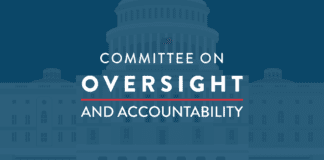Looking at the characteristics of the results of the March 9 presidential election:
1. After a neck-and-neck race, Yoon Seok-youl won by a narrow margin (0.73%).
Yoon Seok-youl beat his opponent Lee Jae-myung and was elected as president in a neck-and-neck race during the 20th presidential election held on March 9, 2022. According to the results posted by the National Election Commission (NEC) on its website, 34,067,853 out of 44,197,692 registered voters voted, and the final turnout was 77.08%.
Of the 33,760,311 valid votes excluding 307,542 invalid votes, Lee Jae-myung won 16,147,738 votes (47.83%) and Yoon Seok-youl won 16,394,815 (48.56%)—a difference of 247,077 votes (0.73%).
2. Record high early voting turnout (36.93%).
16,323,602 people voted during the early voting period, held between March 4 and 5, with the early voting turnout being 36.93%, more than 10% higher than the April 15, 2020 general election, which recorded the then-highest early voting rate of 26.69%. The NEC and the incumbent Democratic Party of Korea (DP) actively encouraged early voting from the start, and the opposition People Power Party (PPP), who hesitated at first, eventually went along, encouraging the people to participate in early voting. Even considering this and that the election day turnout was 40.15%, it means that one in two voters participated in early voting, which can be seen as an unusually high turnout for early voting.
3. Despite the high early voting turnout, the exit poll accurately predicted the results.
In an exit poll released just before the votes were counted by the three major broadcasting stations, they predicted that Yoon Seok-youl would win by a margin of 0.6% with 48.4% of the votes and Lee Jae-myung with 47.8%. Whereas a separate exit poll conducted by JTBC predicted that Lee would win by a margin of 0.7% with 48.4 percent and Yoon with 47.7% of the votes. Ultimately, the exit polls of the three broadcasting stations accurately predicted the final votes between the two candidates within 0.2% whereas JTBC was within 0.9%.

4. According to a poll conducted before election day, Yoon Seok-youl was at a 3-6% advantage.
In accordance with South Korean electoral law, opinion polls between March 3 and 9 were prohibited from being released to the public, but a poll taken during that time showed that Yoon was at a 3-8% advantage over Lee Jae-myung, which was much different from the actual result. In a poll on the approval ratings of Lee Jae-myung versus Yoon Seok-youl conducted days before election day (March 7-8), Gallup Korea predicted 40.0% to 46.0%, Research View predicted 44.5% to 52.1%, and Realmeter predicted 47.1% to 50.2% with Yoon coming out on top.
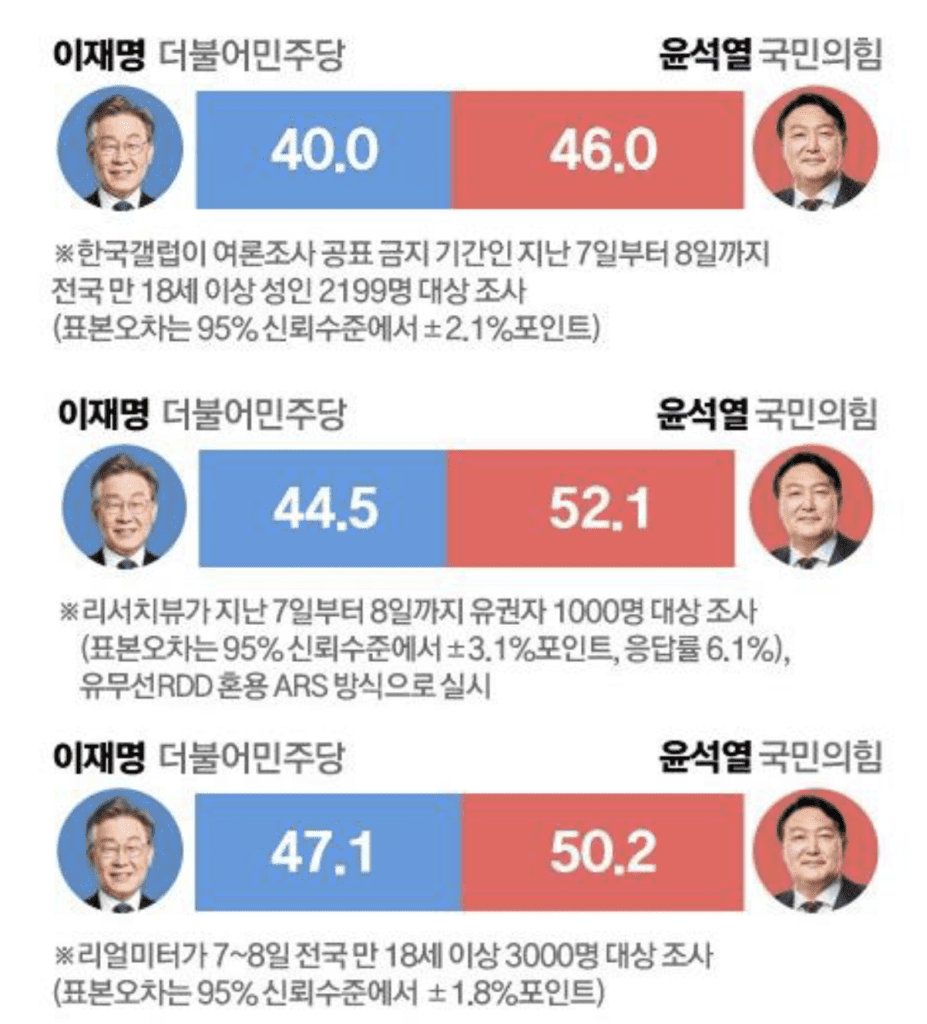
A development that makes people suspect election fraud:
Just looking at the results of this presidential election, there are suspicions among the public that election fraud could have been committed during this 20th presidential election. Various civic organizations monitoring for election irregularities during this election period, including early voting, experienced and observed a series of circumstances and have collected what could be evidence of election fraud.
The most suspect aspect of this election is the possible manipulation of the early voting process. These suspicions stem from the results of the close vote count that would be difficult to comprehend if massive amounts of votes for Lee Jae-myung had not been illegally inserted through early voting. In other words, the that possibility that the voting rate for Lee Jae-myung during early voting was purposefully increased is a key suspicion commonly presented by many organizations raising concerns about election irregularities.
Accordingly, experts who have argued for election irregularities for the earlier April 15, 2020 general election suggest that the following cases were established and implemented as planned in this presidential election.
1. Lee Jae-myung produced additional votes to create a neck-and-neck race to win.
To elect Lee Jae-myung in the March 9 presidential election, a considerable number of additional votes (at least 3 million votes) were manipulated by means of election engineering.
This is a closely calculated number through precise poll analysis, and the number of additional votes required to create a scenario in which Lee, who is losing by 6-7%, beats Yoon Seok-youl by more than 1% with 3 million votes.
2. Manipulating public opinion to accept Lee Jae-myung’s neck-and-neck race.
It would have been necessary to manipulate public opinion by repeating the argument by ruling party leaders and several media outlets that “It’s a neck-and-neck race between Lee and Yoon with Lee to win within a 1% margin” just a day before the polls were prohibited from releasing any results before the election.
Even though Yoon Seok-youl was leading the polls by 4-10% before election day, indeed, ruling party leaders (Lee Hae-chan, Woo Sang-ho, Song Young-gil, Ryu Si-min) repeatedly spoke on air as if they knew the results of the early voting in advance.
3. Intentionally securing most of the additional votes needed during early voting.
During the three days before election day and after early voting, they would have used the situation where there was no CCTV monitoring of the early voting ballot box or could have created early voting ballots and placed them into the box through other means.
There were many cases of storing early voting ballot boxes for a long period in several local election offices and in locations where CCTVs were not present or the cameras were blocked.
On March 7, the Bucheon City Election Commission kept the outside jurisdiction early voting ballots in an office where its CCTVs were covered up, and on March 5, the election integrity monitoring team found an early voting ballot box stored in the office of the executive director of the Jeju Election Commission. In addition, CCTV was installed and operated 24 hours a day in the early voting ballot box storage room, but the monitoring team pointed out that there was a vulnerable time (during the night) for monitoring the ballot box because CCTV footage could not be seen after the staff had left for the day. Although the NEC operates an integrated CCTV control center and observers are always monitoring it, it is unclear whether those monitoring thousands of CCTVs will effectively detect all improper activities.
There is room for the fraudulent mass production of early voting ballots before and after by having the signature of the early voting manager, not their “personal stamp”, made by the NEC on the seal. If personal stamps or stamps made by the NEC were previously used, this time, an official seal containing the name of the site manager was used. Many have pointed out that the NEC has never yielded this much, which is a disproof of their sincerity in their willingness to hold a fair election.
It was also pointed out that the early voting ballot box seal was poorly made, so the effectiveness of preventing unauthorized opening of the ballot box could not be guaranteed, and that there was room for fake ballots to be stuffed without the observers knowing. If it were to be found that one person had signed five signatures on the seal, it can be argued that it can’t be determined if local election committees attached a seal to the first empty ballot box and later removed it.
In addition, since early voting uses an electronic voter list, it is difficult to accurately compare the number of votes cast and the actual number of ballots marked in real-time. So, even if there are observers, there is the chance of ghost votes and multiple votes (proxy votes) to be cast. As such, it has been raised that early voting is relatively easier to increase the number of ghost voters (such as stuffing fake ballots or multiple proxy voting while going to various polling stations) compared to election day voting.
4. Announcing a calculated exit poll to encourage public opinion to accept a neck-and-neck race.
By manipulating and correcting the expected early votes in the exit polls conducted by the three broadcasting stations, announcing the results of the exit polls, which combines the election day and early votes, so that they can be naturally accepted by the public. The three broadcasting stations predicted that Yoon Seok-youl would win by +0.6%, and with JTBC predicting in a separate poll that Lee Jae-myung would win by +0.7%, it created a situation where most people may recognize that the results from the exit polls are not that different had Lee Jae-myung won within a 1% margin.
5. The minimum amount of election day manipulation occurred so that it does not arouse suspicion of election fraud.
It has been pointed out that by not interfering with other parts of the vote-counting process, getting caught manipulating the votes, in general, could be avoided. On the other hand, additional fraudulent votes could be created for election day votes by using separate voting methods for COVID-19 confirmed patients.
Due to the activities of many civic organizations calling for the investigation into the April 15, 2020 fraudulent election, many people were aware of and alert to the possibility of a repeat of the April 15 general election and were suspicious of everything. In addition, a large-scale election irregularities monitoring team was active, and if serious evidence of manipulation was found during the counting process, there was a risk of it developing into an uncontrollable situation.
Therefore, it is assumed that by accepting the demand to install CCTVs in the early voting ballot storage room and opening the early voting boxes and counting them before counting the election day ballot boxes, the government has attempted to make the public aware that it made sufficient efforts to improve the system. As soon as the early voting ballots were being counted after election day votes during the April 15, 2020 general election, a considerable number of metropolitan districts where the candidates from the ruling party who were losing, suddenly were getting large numbers of votes. This caused many people to doubt the early voting results.
Therefore, during this election, it could be said that it was less shocking to the people to see Lee Jae-myung leading Yoon Seok-youl by 7 to 8% in the beginning by counting the early voting ballots first as requested by the civic groups and the PPP. The votes cast on election day were in favor of Yoon Seok-youl, so once the election day votes were counted, Lee Jae-myung’s lead started to decrease and the gap narrowed as the votes were counted. However, until all votes were counted, the tide did not turn and the close race of around 1% lasted for a long time, and in the process, if Yoon closed the gap and eventually lost without reversing the tide, the people would have said, “Yoon Seok-youl lost by a narrow margin. The early voting turnout was very high this time, and I think it worked in Lee Jae-myung’s favor.”
This scene appeared in a broadcast of the vote-counting process in this presidential election. The only difference is that at around 1 a.m. during the final hours of counting the votes, a golden cross (short-term average crosses above a long-term average) occurred where Yoon Seok-youl’s votes outpaced Lee Jae-myung and continued to maintain an advantage of 0.5 to 0.9% until the end of the count. If this “golden cross” had not occurred, the scenario in which Lee had a narrow lead within a 1% margin and eventually won in a neck-and-neck race could have been achieved.
It should be noted that if there was a meticulous manipulation of the election, the cause of why it did not proceed according to the perpetrators’ plans should be found. In other words, which unexpected variables occurred will help us understand the nature of the election irregularities.
A series of irregularities and specific evidence:
The National Election Commission and the Democratic Party encouraged early voting.
Originally, South Korean election policy was that it is the rule to vote on election day and early voting should be an option in case one cannot vote on election day, but in recent elections, excessive encouragement to participate in early voting is becoming common practice. In addition, the DP has stated that a high early voting turnout would be advantageous for Lee Jae-myung and encouraged early voting at the party level. Also, the NEC filed a complaint with the prosecution against Hwang Kyo-ahn, former chairman of the United Future Party, Min Kyung-wook, a former lawmaker for the Liberty Korea Party, and Gong Byung-ho, director of the Gong Byung-ho Management Research Institute. The NEC took legal action against key figures who were protesting early voting ahead of the presidential election.
Major figures, such as Yoon Seok-youl and Kwon Young-se, head of the election campaign, belatedly began to encourage early voting for the presidential election. The People Power Party refrained from commenting to avoid conflicts with those who insisted that election fraud occurred during the April 15, 2020 general election within the opposition, but it seems to have shifted its strategy due to the rampant spread of the Omicron variant of COVID-19.
Considering that early voting has become a hotbed for claims of election irregularities in the April 15 general election, it can be interpreted that encouraging participation in early voting during this presidential election to actively induce a high early voting turnout is intended to create conditions easier to manipulate elections using early voting.
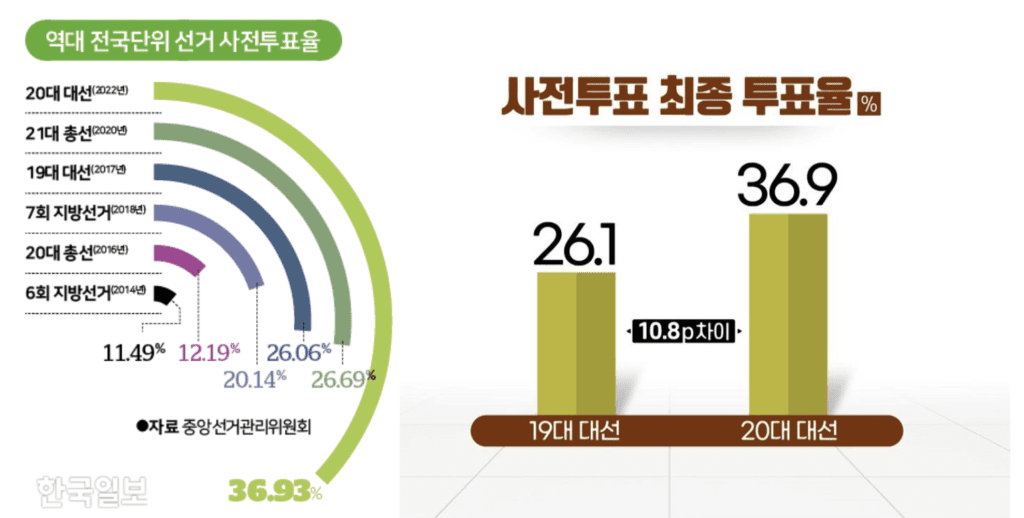
The all-too accurate results of the exit polls are evidence of an elaborate election fraud scheme.
The accurate results of the exit polls conducted by the three broadcasting stations predicted 47.8% of votes for Lee Jae-myung and 48.4% for Yoon Seok-youl, while a separate poll conducted by JTBC predicted 48.4% for Lee and 47.7% for Yoon, expecting Lee to lead by 0.7%. With a very accurate prediction of the results of an ultra-close presidential election, some of the media and the people are saying that the method of these pre-exit polls has been modernized and has excellent accuracy.
However, since the exit poll was conducted through a verbal survey selecting one out of five people at polling stations on election day, it is quite natural to accurately predict the results of the election day voting, but it is not scientifically possible to predict the overall voting results. It is said that the exit survey team correctly predicted the early voting results through telephone surveys to accurately predict the overall voting results and reflected them in the exit poll. As seen during this election, with early voting accounting for nearly half (48%) of the total votes, it is valid for the exit poll to have some errors without accurately predicting the overall results.
The exit poll is conducted only on election day with 73,297 voters at 350 polling stations nationwide. On the other hand, the prediction of the early voting results is made through a telephone survey, surveying about 10,000 people. Therefore, the most accurate prediction in the exit poll results is based on the election day voting results, and it is correct that the prediction of the early voting results is relatively less accurate. Thus, in the exit polls, it would be correct that the prediction of the final results is relatively less accurate than the accuracy of the election day’s votes because the predictions for the final results include predictions of the early votes which are less accurate.
In the exit poll conducted by the three major broadcasting stations, according to the telephone survey of early voting, they predicted that Lee Jae-myung would get 51.7% of the votes and Yoon Seok-youl with 44.7%. For election day voting, they predicted that Lee would get 44.1% of the votes and Yoon with 51.9%, and the total expected votes would be Lee with 48.8% and Yoon with 48.4%.
On the other hand, the actual votes of the two tabulated by the National Election Commission were 52.57% for Lee Jae-myung and 43.82% for Yoon Seok-youl in early voting, 39.08% for Lee and 56.24% for Yoon in election day, so the final results were 47.8% for Lee and 48.6% for Yoon.
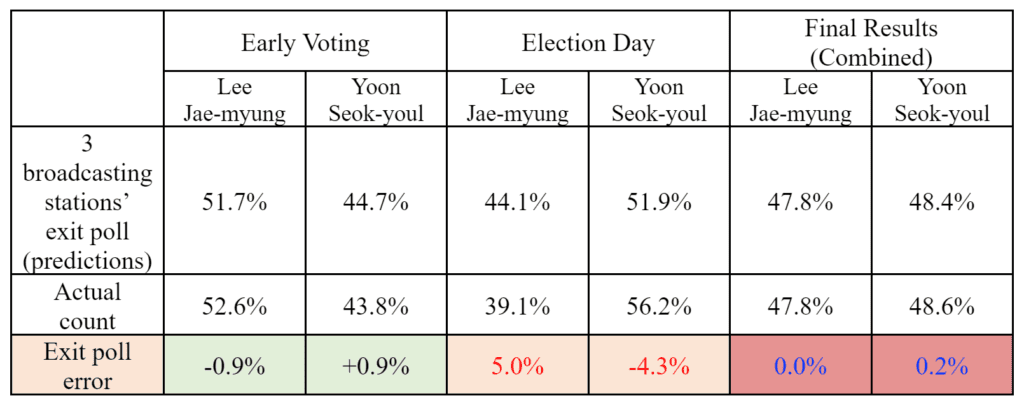
Analyzing this result shows that the exit poll results are absurd and likely to have been manipulated.
The exit poll showed a large error of 5.0% for Lee Jae-myung and -4.3% for Yoon Seok-youl on election day votes, while -0.9% for Lee and +0.9% for Yoon on the early voting votes, which is more accurate. More surprisingly, despite the inaccurate prediction of the election day voting results in the range of 4-5% and including the early voting results, the final voting results were exactly the same with Lee Jae-myung and Yoon Seok-youl predicting a 0.2% margin of error.
It can be said that the analysis of the results of the exit polls is very serious. Despite that the exit poll had an error of 4-5% on the election day voting results, the final result was accurately predicted within the range of 0.2%. In other words, it means that a very accurate final result (final vote) was produced by processing the count with inaccurate source data (the prediction of the election day votes). If there is meaning to be found in the accuracy of the prediction of the final result of the exit poll, at least the prediction of the voting result on election day must be similarly accurate. Is this a coincidence? Even if they admit it’s a coincidence, it should not be determined that the exit poll results were scientifically accurate. If the exit poll was accurate, shouldn’t the prediction of the election day voting results at least be accurate?
The NEC’s selective measures create doubt about the authenticity of a fair election.
The measures necessary to prevent illegal voting can be substantially prevented by making certain basic things clear. That includes CCTV surveillance of early voting ballot boxes, use of reliable seals, use of personal stamps of voting managers at polling stations and opening of early voting ballot boxes before election day ballot boxes for counting. To quell these suspicions, it was decided to open the early voting ballot boxes first.
To clear any doubts about election fraud, the NEC took measures to accept some requests made by election fraud monitoring organizations and the PPP, but it can be said that the NEC’s sincerity to prevent election irregularities has been questioned, such as refusing to accept the most important demands like the use of personal seals by the polling managers.
Lax CCTV surveillance of early voting ballot boxes.
CCTVs were installed in the area where the early voting ballot boxes were stored and measures were taken to monitor it 24 hours a day, but this seems to be a pro-forma way to quell suspicions about early voting.
For the CCTV surveillance of early voting ballot boxes to be effective, CCTVs should be installed in the early voting box storage area and the boxes transported in the presence of an escort of police and observers until the early voting box arrives in storage, it should be stored in the location with the CCTV installed as soon as it arrives in the local election commission’s office, monitored 24 hours a day, and when moving to the counting station on election day, the police convoy should be the escort and in the presence of an observer. However, it’s been discovered that there were several serious cases in which such procedures were not followed during this presidential election.
The CCTVs were installed, but a screen capable of monitoring the footage was within the entrance of the NEC office, so outside observers could not monitor the CCTV after the NEC staff had left for the day. The NEC argues that its comprehensive control system allows observers to monitor, but this goes against the purpose of installing CCTVs because thousands of CCTVs cannot be monitored by several observers. In other words, there is still a chance for someone to avoid surveillance by CCTV by somehow rigging the early voting ballot box in the storage location.
The fact that some local election committees store a large number of early voting ballot boxes in their secretariat’s office, which does not have CCTV installed, proves the claim that there is a considerable chance to disable CCTVs. The fact that it is stored in an office is against the rules, and it was confirmed that the camera was covered with a paper cup and that no cameras were installed in the office. From these examples, it can be assumed that the office of the secretary-general of the local election commission has been used as a blind spot to allow possible manipulation of the ballot boxes, including during previous elections.
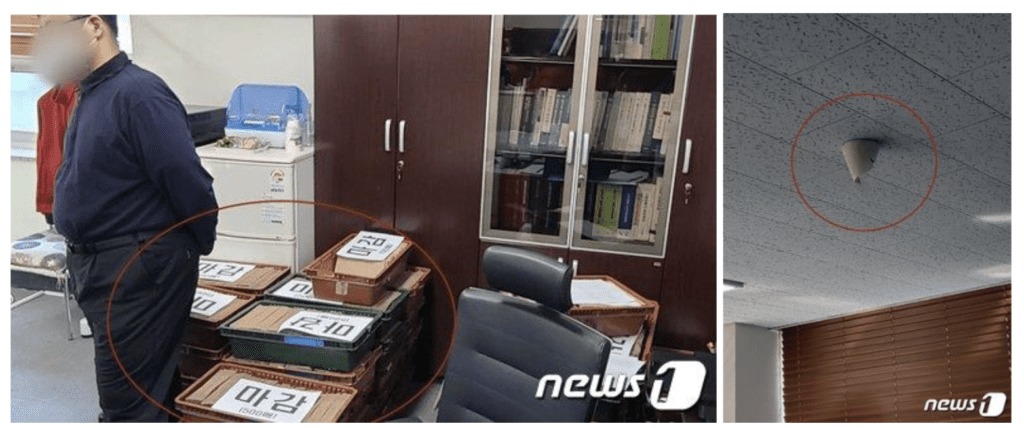
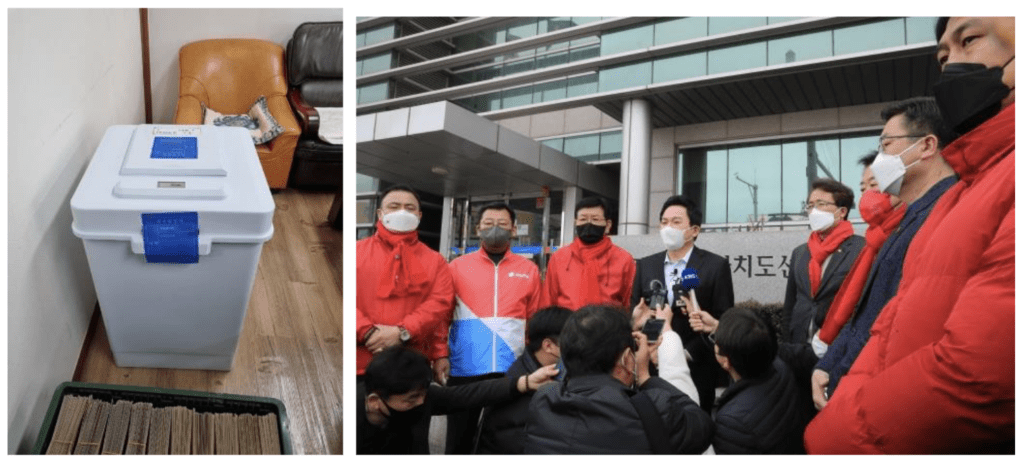
Ineffective seals and poor management.
There were many suspicions about the ineffective seals during the April 15, 2020 general election. To quell these suspicions and allegations of election fraud, the NEC used a “special seal” with a holographic seal. However, these so-called “special seals” used during this election do not leave a trace if the seal was removed, so its function as a seal is improper and compromised.
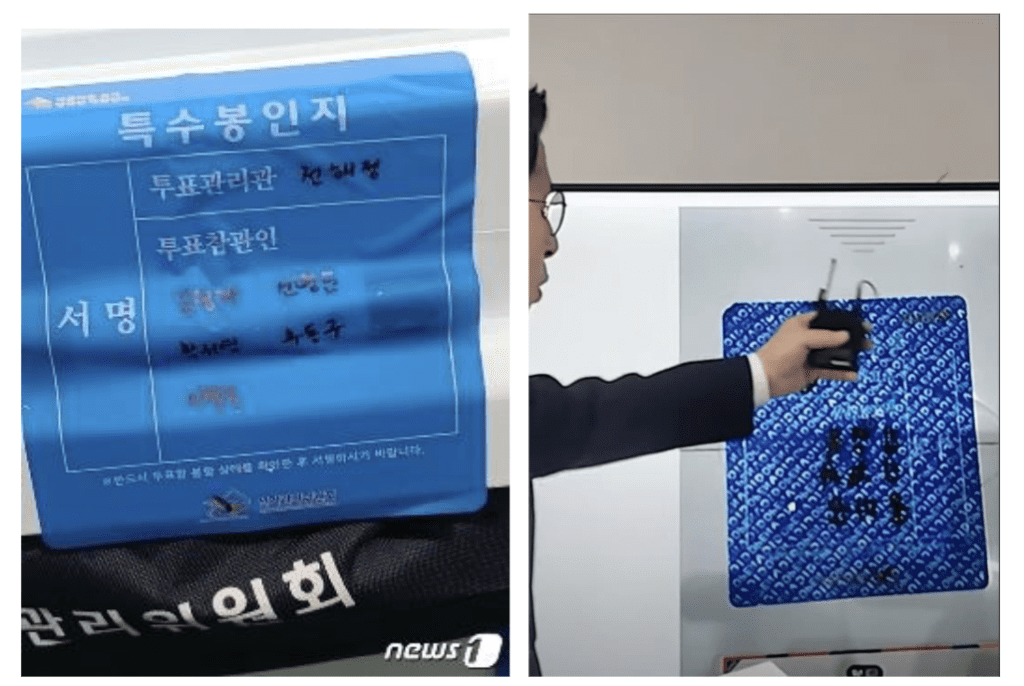
After the vote, the seal signed by the observer should be attached, and the ballot box should not be opened until it is time for the votes to be counted, but if the ballot box was opened, the seal should be damaged. However, the seal did not function properly enough to play its role. Also, several election commissions have previously attached a seal to an empty ballot box to remove the seal on the day of the vote and then to cast votes, so that even if there are signs of removing the ballot in advance, they must have used an irregular method to prevent complaints being raised.
What is the reason for attaching a seal to an empty ballot box? The monitoring team wanted to check whether the ballot box was empty, but the NEC rejected their request. Even if a ballot box contained illegal ballots prior to the election, we will never know. This is because the ballot box is opaque and the contents can’t be seen. Therefore, if illegal ballots were put in the ballot box in advance, the seal on the ballot box is removed on election day, and people are beginning to vote, it would be impossible to confirm whether illegal ballots were already put into the ballot box. The ballot boxes can be made transparent so that the inside can be seen, and it is essential to open the ballot box in the presence of observers before voting begins to confirm that the ballot box is indeed empty.
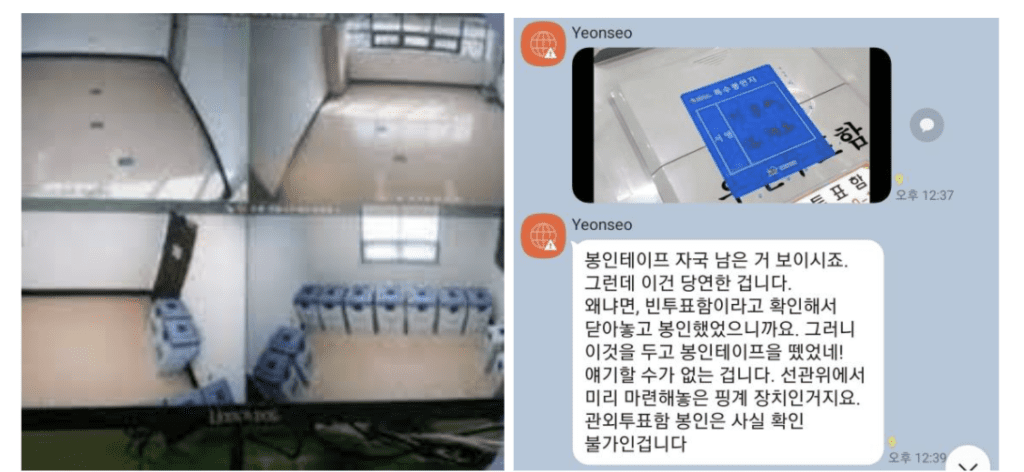
Poll managers had to use stamps created by the National Election Commission.
Poll station managers must use their own personal stamps, but one was created by the NEC giving an opportunity for mass production of illegal ballots in advance or using stamps that look like seals and sending it down to local election commissions prior to election day. Many argue that the main cause for allegations of election irregularities comes from the requirement that personal stamps must be used by the poll managers, but the decision to use these stamps in the form of seals leaves room for the production of illegal ballots, which contradicts the NEC’s promise to prevent election irregularities from happening. If they were sincere in their intention to prevent election fraud, they must follow the law that stipulates that poll managers should use their own personal stamps. The use of these stamps created for the election can only be seen as neglecting the possibility of producing illegal ballots.
In addition, the reason why the Public Official Election Act stipulates that the poll manager’s personal stamp is to be stamped on the ballot at the polling station is that the ballot cannot be illegally created at any place except at a fixed time (voting time) and space (poll station). Nevertheless, the NEC did not accept the demand for the use of poll managers’ personal stamps, which many election irregularities monitoring groups have been demanding as a priority.
During this election, as in the April 15 general election, the stamp in the form of an official seal produced by the NEC and sent to local election commissions was used. This deliberately ignores the most basic precautions to prevent election fraud, disproving the claim that NEC has no will to prevent election irregularities.
Possibility of inserting illegal ballots using the separate ballots used by COVID-19 confirmed patients.
The voting method set by the National Election Commission is as follows: At a set time, the COVID-19 confirmed patient will not go to a regular polling station, but there will be a marked box in front of the waiting line and instead, someone will put their ballots into this box where an NEC staff will collect and put it in the official ballot box. It is astonishing that it is possible to physically deliver the ballot by someone other than the voter themselves and put it in the ballot box instead without objective monitors such as observers or police at the scene.
At one voting site, there was a case where one voter received an envelope containing a ballot, there was already a ballot marked for a certain candidate (Lee Jae-myung). At the Sinsa 1-dong Community Center, three people received ballots marked for candidate number 1 (Lee Jae-Myung), and at Shinwol 6-dong, Yangcheon-gu, there was also a ballot found marked for number 1. The NEC explained that it was a simple mistake that occurred while distributing envelopes, but the fact that there were marked ballots can be seen as intent to defraud the election.
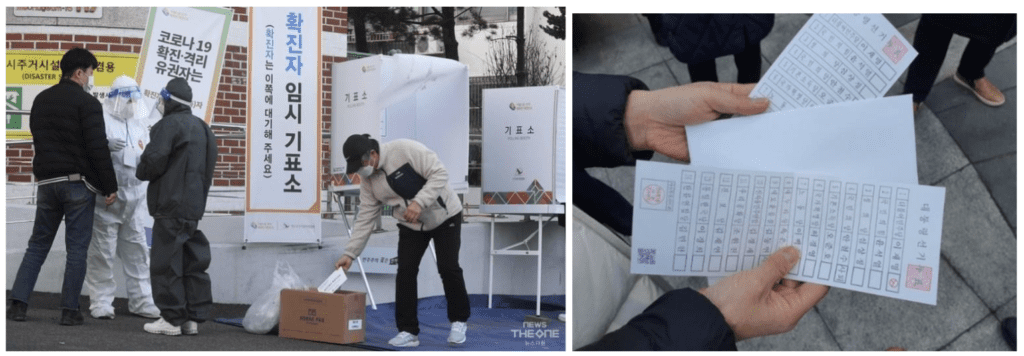
On the second day of early voting, many complaints were made, such as noise at the site and destroying the principle of direct voting, causing Roh Jung-hee, the head of the NEC, to hold a press conference to apologize. Accordingly, procedures originally made by the NEC did not apply to election day, so if it was intended to change out the ballot during this process, it can be seen that their intention was crushed. This means that it became difficult to attempt to illegally create more votes for specific candidates in advance or on election day.
Suspected illegal ballots were inserted due to the discovery of large amounts of ballots in different colors.
On March 9, a large number of different colored ballots were found at the ballot counting sites in Namdong-gu, Incheon, and Yeongdo-gu, Busan, and the counting was temporarily suspended due to an observer raising an issue with this. Observers from the People Power Party protested, “Several early voting ballots of different colors, such as bright white and light yellow, came out of the opened boxes.” The National Election Commission gave inconsistent explanations, “The reason why the ballots are slightly different in color is that we used different manufacturers,” or, “The degree of discoloration of the rolled paper may vary depending on the production period and how it was stored,” and said, “There is no problem.” They unilaterally resumed the counting of votes, “These are official ballots that have been stamped by the early voting manager.”
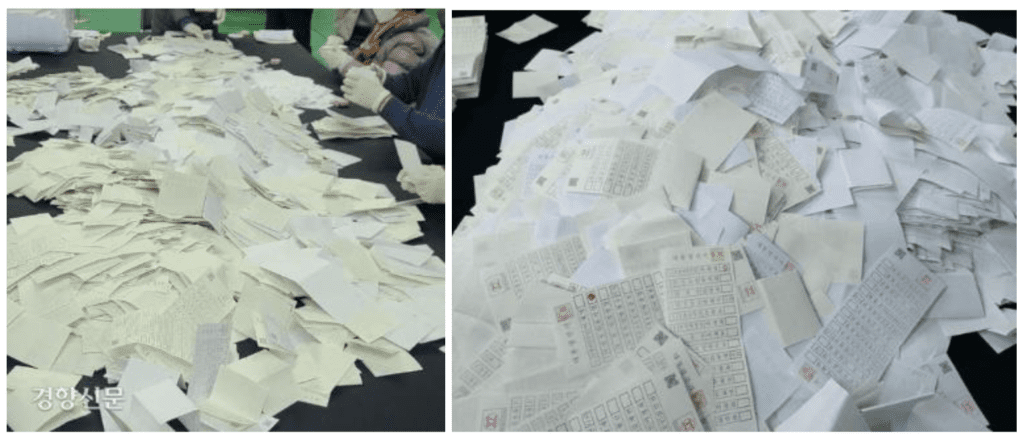
In general, ballots are printed on specially-made white papers that have to go through strict quality standards by a small number of designated companies such as ‘Moorim’ and “Hansol Paper,’ and are printed at designated printing shops and undergo specific inspection. Therefore, it is very unusual for a large number of different colored ballots to be found at certain polling stations, and it is suspected that illegally manufactured ballots were stuffed into the ballot boxes, thus giving claim that this is a “smoking gun for election fraud.”
Suspicious ballot boxes were found on the street sparking speculations of election fraud.
At 8 p.m. on March 9, the election irregularities monitoring team operated by Hoverlab witnessed an unidentified man and woman moving a ballot box on the street without an escort of police and observers near the Bupyeong-gu polling station, which was being live-streamed on YouTube. Afterward, the police were called and the confrontation reportedly continued until 11 p.m. With more than 300,000 people watching the YouTube Livestream through channels such as Hoverlab and BJtol, the situation unfolded with many citizens gathering to protest and shouting that this was “election fraud.” The Incheon Election Commission said that this certain ballot box was an official ballot box and had nothing to do with election fraud, and rather filed a complaint with the Incheon Metropolitan Police Agency on charges of disturbance and harassment at the polling station.
Election watchdogs claim that this controversial ballot box itself may not be directly related to election fraud, but it at least shows that the management of the ballot box is very poor, such as moving the ballot box without an escort of police or observers.
Found more votes than the actual number of voters at several early voting polling stations.
Ok Eun-ho, who ran as candidate number 8 in this presidential election, asked observers from his political party to count the number of voters participating in early voting with their own eyes. For example, on March 5, the number of voters counted and recorded by observers with their own eyes at the Songpa-gu polling station was 4,713, but the total number of voters was 5,044 in the register roll system after voting was completed. After checking the register roll continuously during the vote, there was no significant difference within 40 votes, it was found that the total cumulative number of votes suddenly increased by 331 votes after the vote was over.
(https://www.youtube.com/watch?v=c2ai8MxpU64)
In addition, several YouTubers installed real-time recording cameras at specific polling stations to record early voting participants entering and leaving the polling stations. As a result of visually checking the actual number of voters who entered the polling station in Samseong-dong, Yangsan, Gyeongsangnam-do, on March 5, 2,072 people voted, but after requesting information, the NEC disclosed that at this particular polling station, on March 5, the number of pre-registered voters within the jurisdiction was 2,788, the number of pre-registered voters from outside the jurisdiction was 431, a total of 3,219 people who had voted at the location. This is 55% more than the actual number of votes, which is a difference that can never be considered an error as it was filmed and may be confirmed on the recorded video files. In terms of this particular polling station, the election day turnout was a 20% difference—40% for Lee Jae-myung and 60% for Yoon Seok-youl, while for early voting, there was a 6% difference—47% for Lee and 53% for Yoon. This is strong evidence suggesting that Lee Jae-myung’s increased vote rate was made possible by ghost votes during the early voting period. It is said that a YouTuber will file a complaint based on the following video.
(https://m.youtube.com/watch?v=ia6u5IIFgVA&feature=youtu.be)
A great difference in voting patterns in the presidential election and parliamentary by-election.
During this presidential election, four parliamentary by-elections were held at the same time. It is meaningful to compare the two results because these are the results made by the same voters who voted at the same polling station on the same day. It isn’t common for voters who support one party on one ballot to vote for another party on the presidential ballot.
In Seocho-gu, Seoul, DP candidate Lee Jung-geun and PPP candidate Cho Eun-hee ran in the by-election. According to the results of the presidential race in Seocho-gu, Yoon Seok-youl dominated with 65% of the votes compared to Lee Jae-myung’s 32% (33% difference), but in the by-election, the DP candidate received 24% of the votes and the PPP candidate received 73% (49% difference). Considering that the presidential and parliamentary elections were held on the same day, it means that 16% of voters cross-voted, which is not a common phenomenon in light of the voting pattern, which is divided by political beliefs.
Civic groups’ active participation by being election watchdogs.
During this presidential election, many civic groups engaged in monitoring for election irregularities due to allegations of fraud during the April 15, 2020 general election. Former Prime Minister Hwang Kyo-ahn operated a nationwide election watchdog team to monitor polling stations, while Hoverlab established election watchdog teams to monitor and record each regional election committee and polling stations for 24 hours. CEO of Media A, Ok Eun-ho, who ran for president for the Saenuri Party under the motto of investigating election fraud, ran a legally permitted party observer, and former lawmaker Min Kyung-wook, who has always insisted on investigating allegations of election fraud, also operated election watchdogs through the Headquarters of the Citizens Struggle Against the April 15 Election Fraud.
The Korean Conservative Political Action Conference (KCPAC) and the Center for Korea America Freedom & Security Policy (KAFSP) jointly hosted a press conference for fair elections to inform the public of the campaign launched by civic groups to monitor for election irregularities.

Also, various YouTube channels like Gong Byung-ho TV continued to collect and share cases of election irregularities found during the presidential election.
Since the presidential election, efforts have been made to create a White Paper by compiling the results from the election watchdogs from these organizations and to create a comprehensive report including measures to improve the election system in the future.
Establishing a fair election system is an important task for the Yoon Seok-youl administration:
Yoon Seok-youl’s narrow victory of 0.73% in this presidential election has led many to interpret this election from the perspective of election irregularities. Significant differences in voter turnout between early voting and election day voting, the neck-and-neck race different from public opinion polls, the possibility of manipulating exit polls, and the poor management of the election by the National Election Commission seem to be affecting the public’s perception of the possibility of election fraud in this presidential election following allegations of fraud in the April 15, 2020 general election. In addition, there are indeed concerns about election irregularities for the upcoming 8th National Simultaneous Local Elections to be held on June 1.
For the development of liberal democracy in South Korea, the issue of election irregularities is a task for the nation to overcome. In order to achieve true national integration under the principle of “fairness and common sense” advocated by the incoming Yoon Seok-youl administration, it is now necessary to establish a fair election system suitable for South Korea’s political and economic status.



